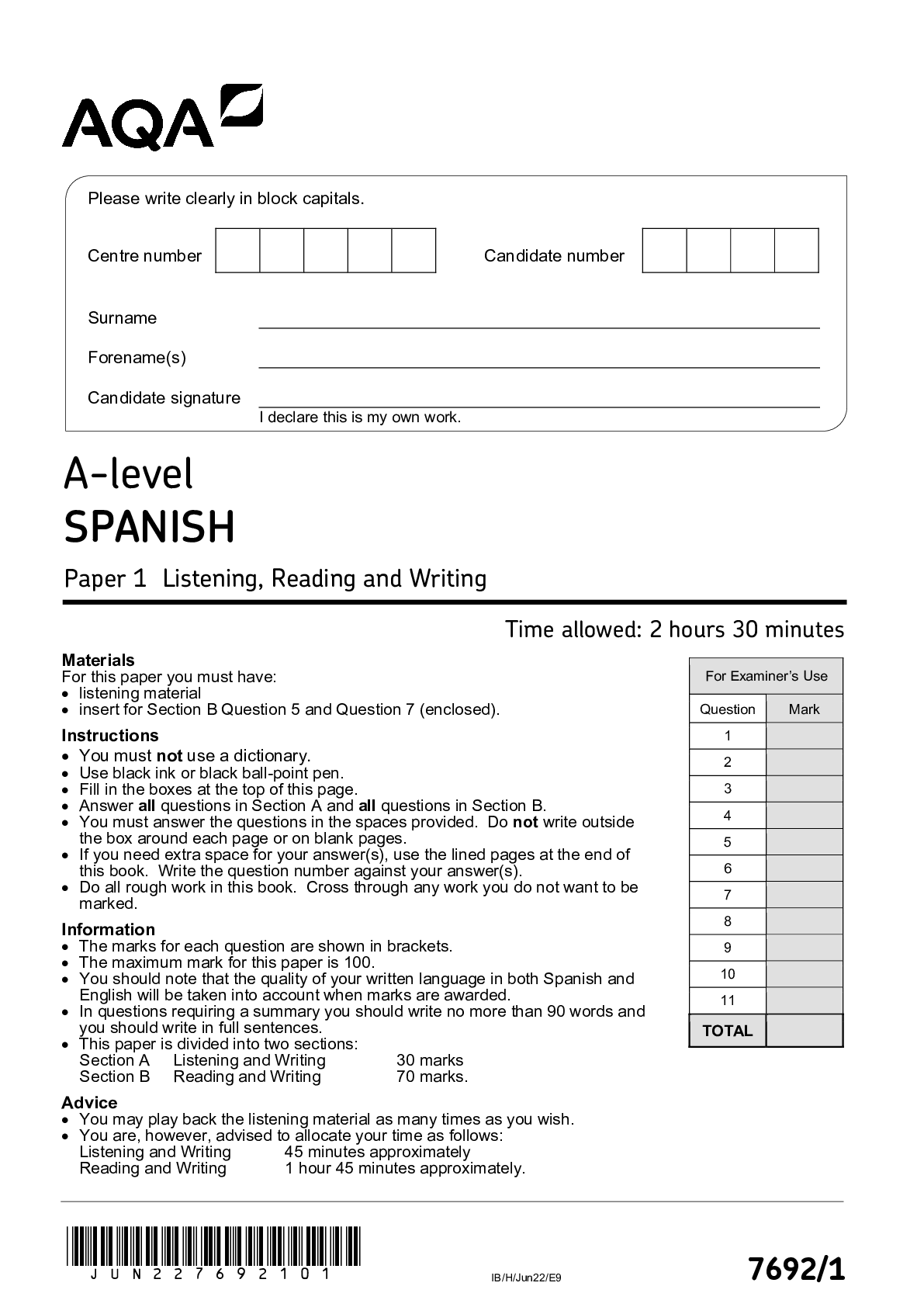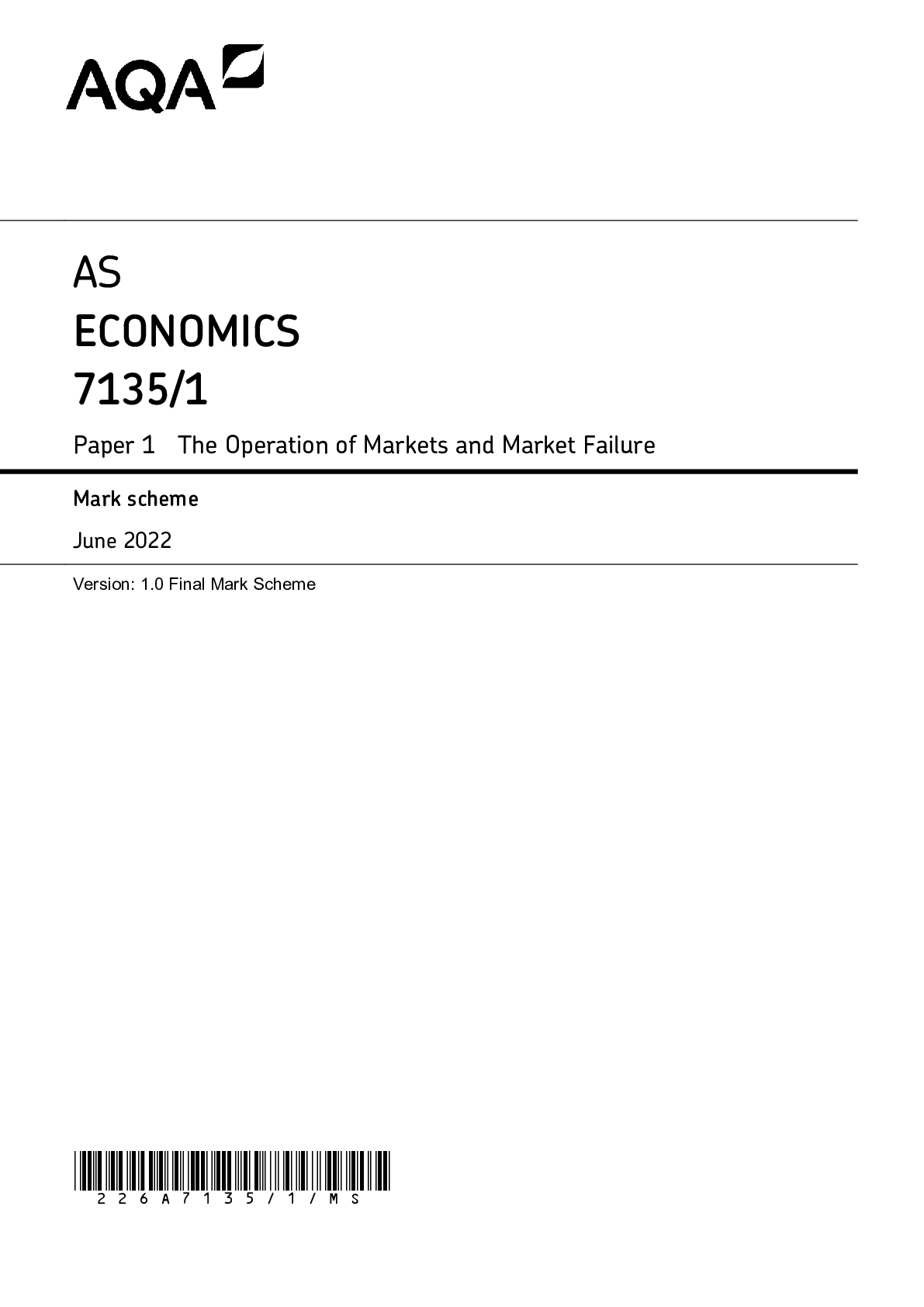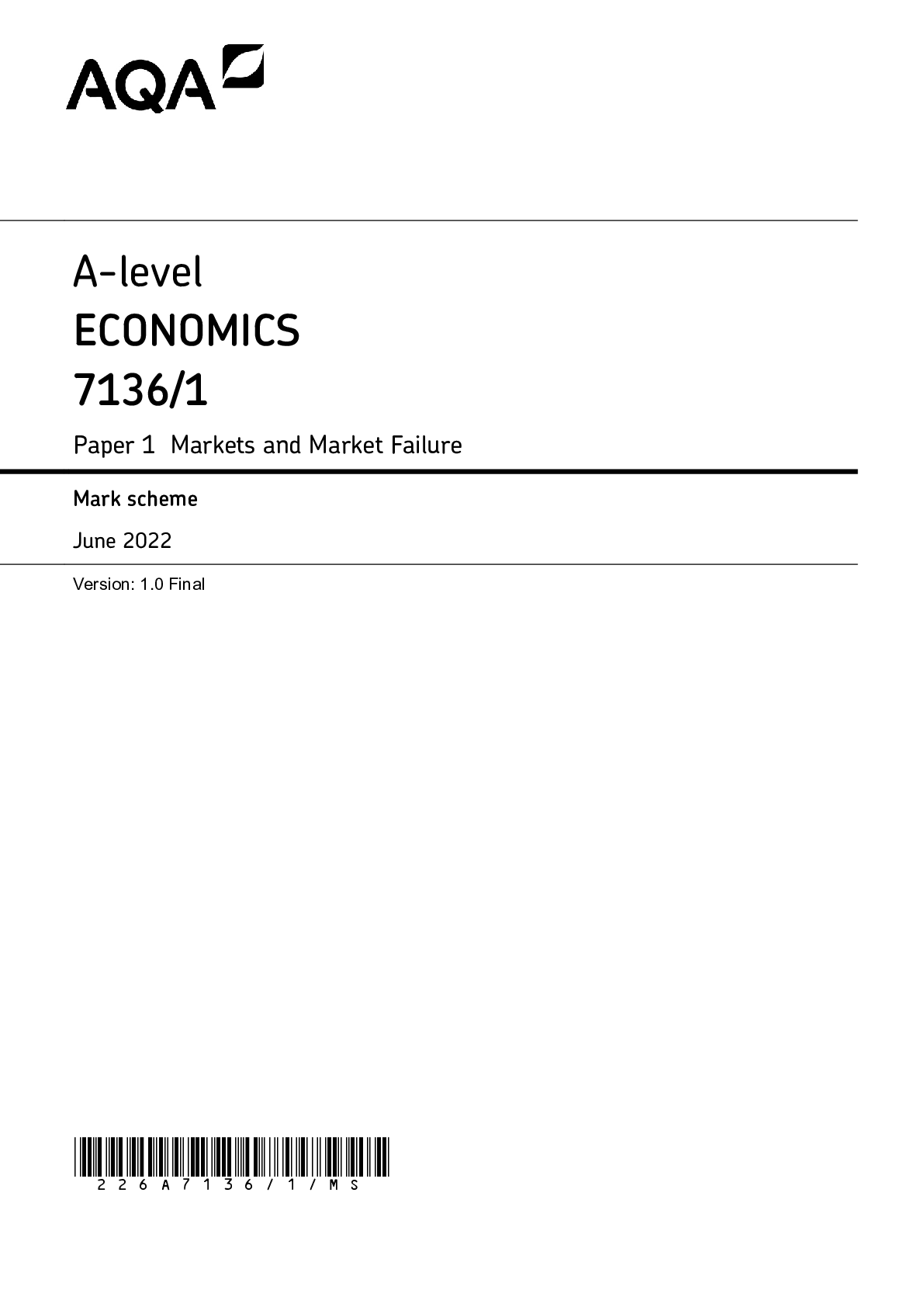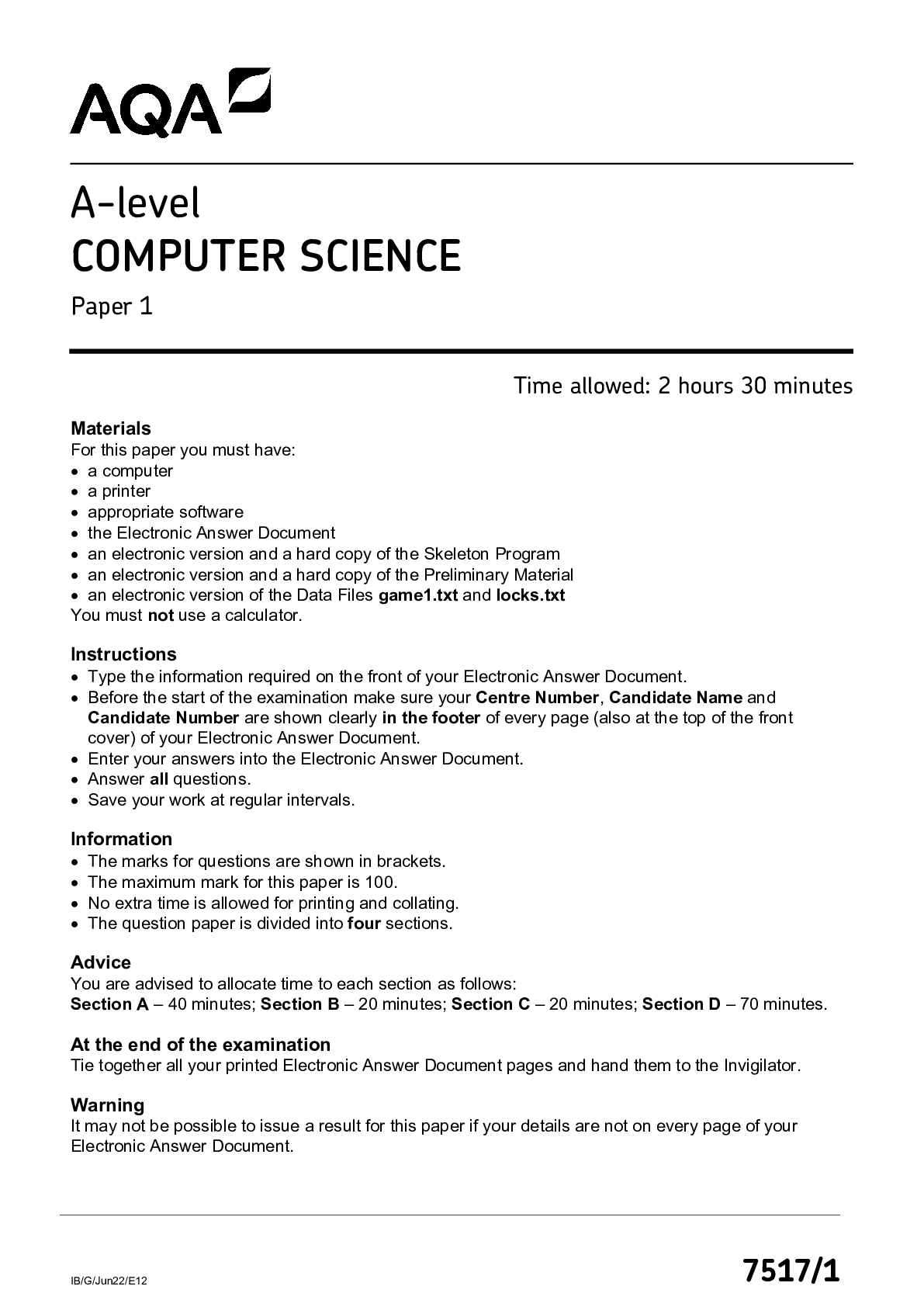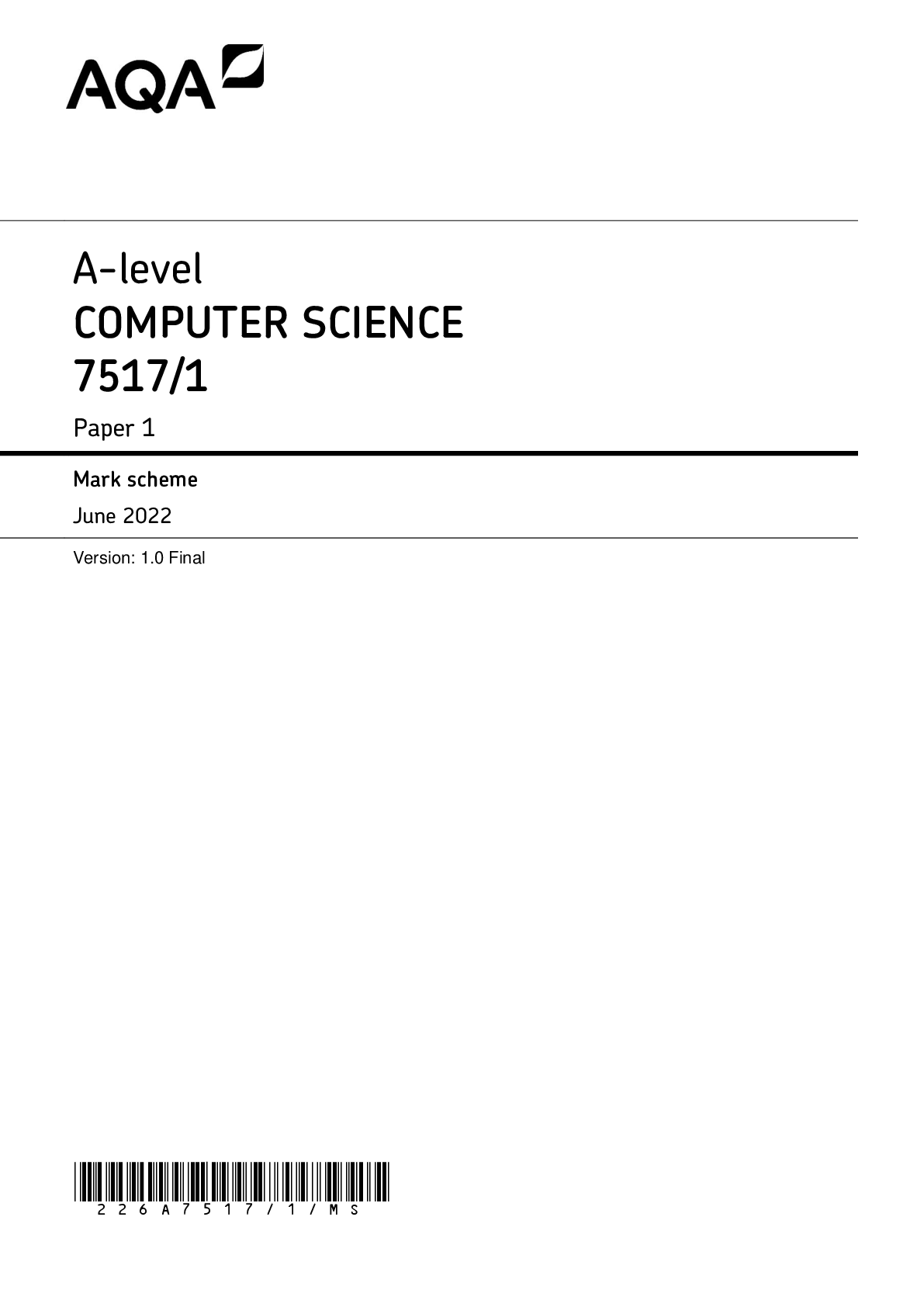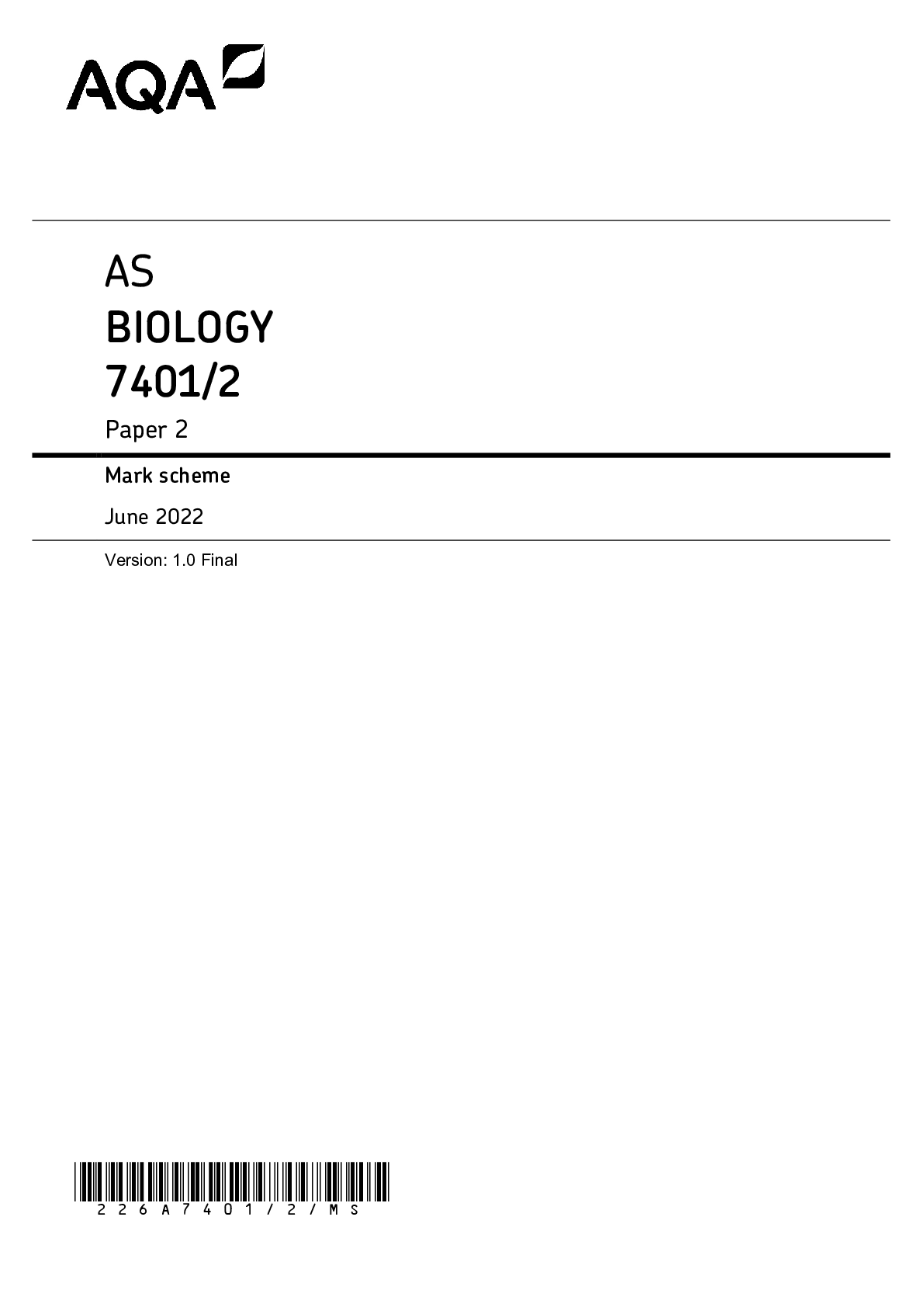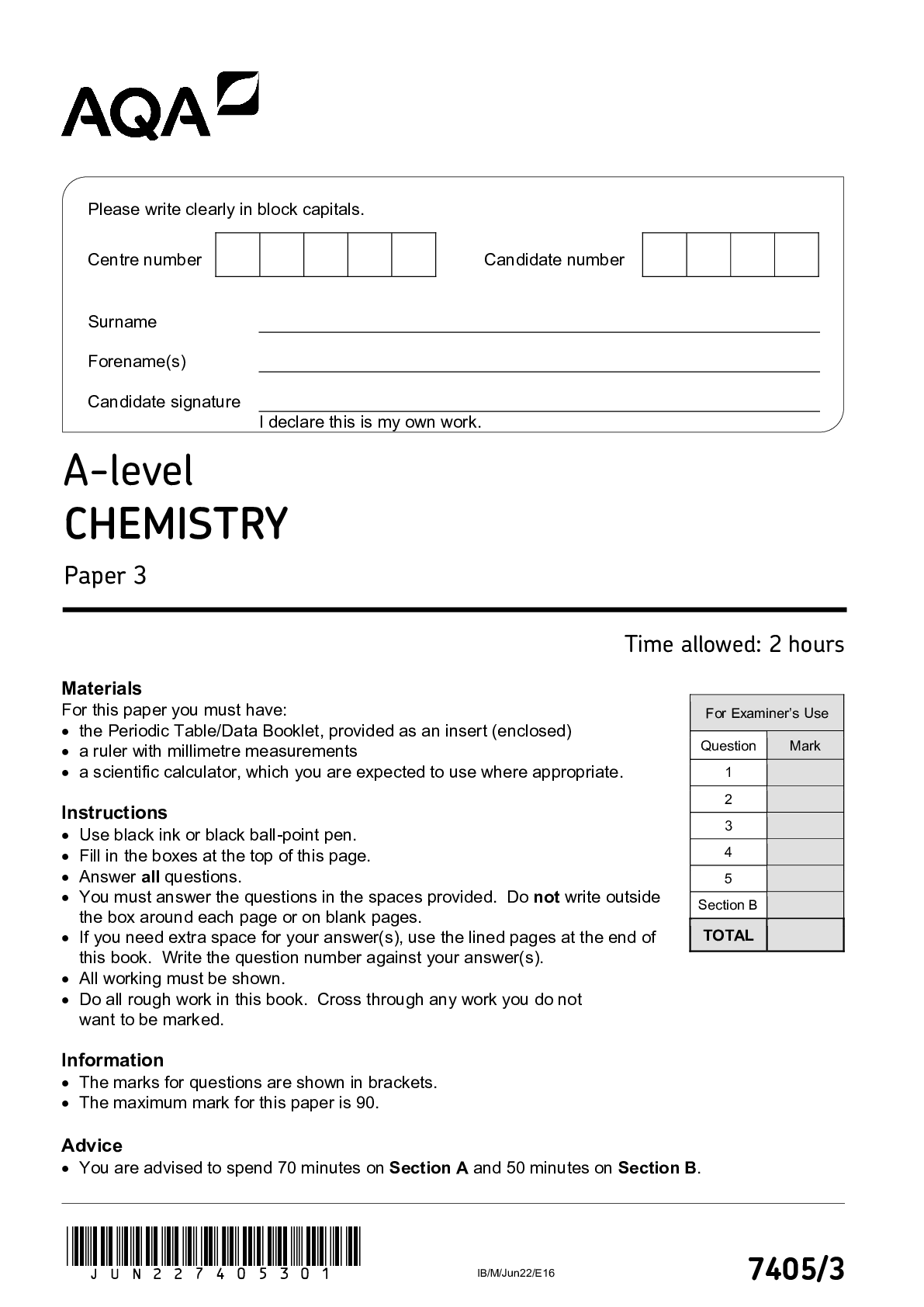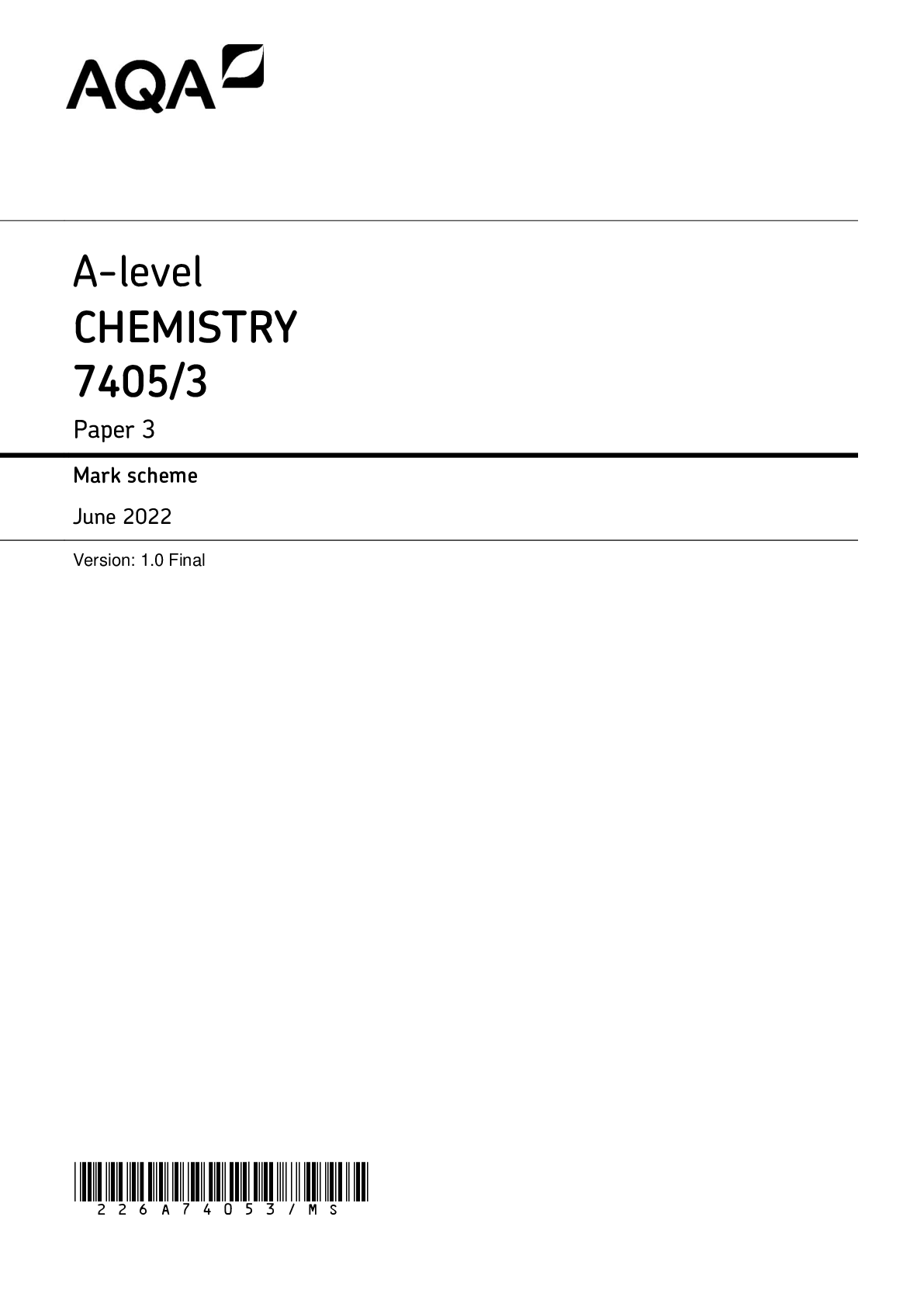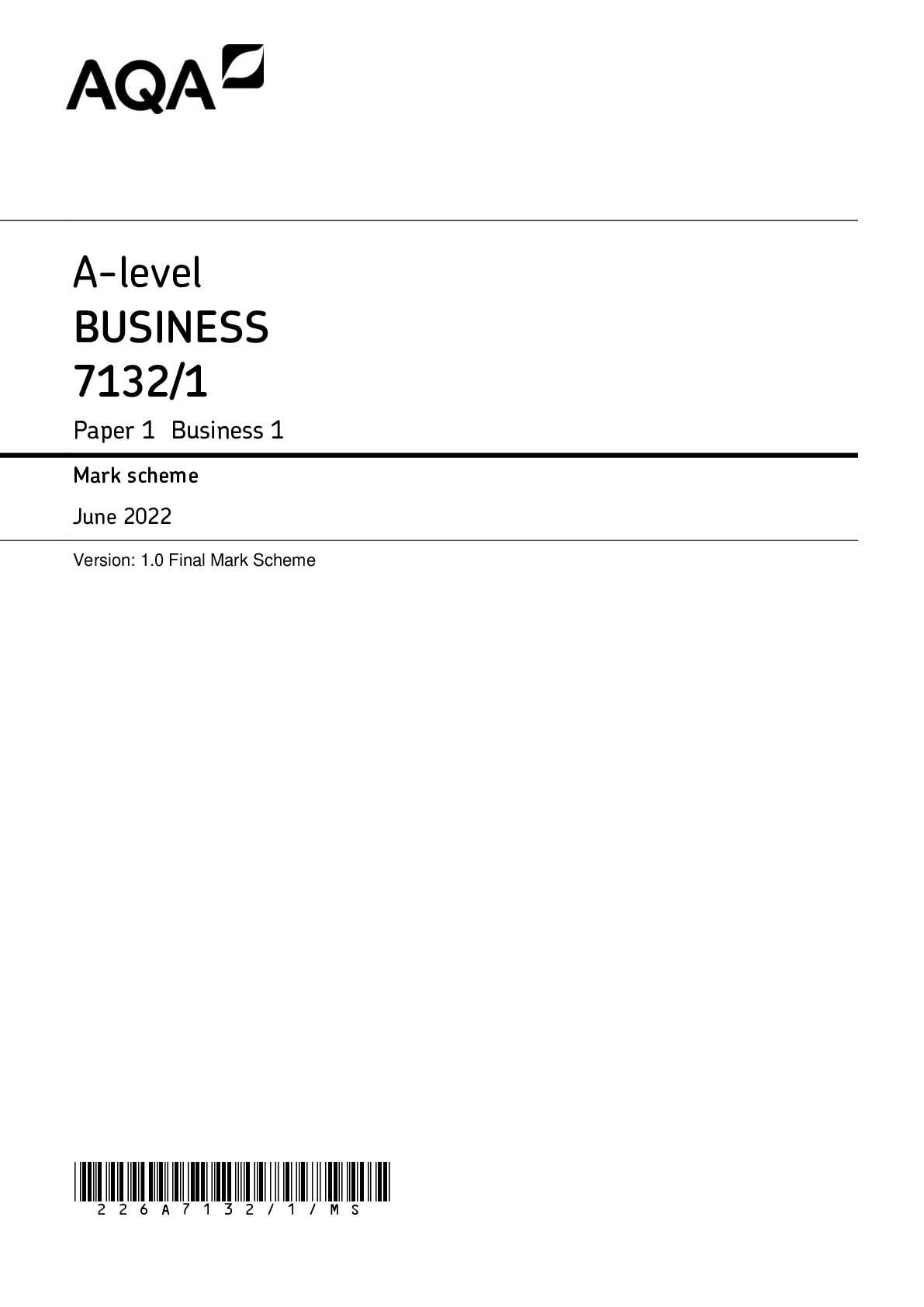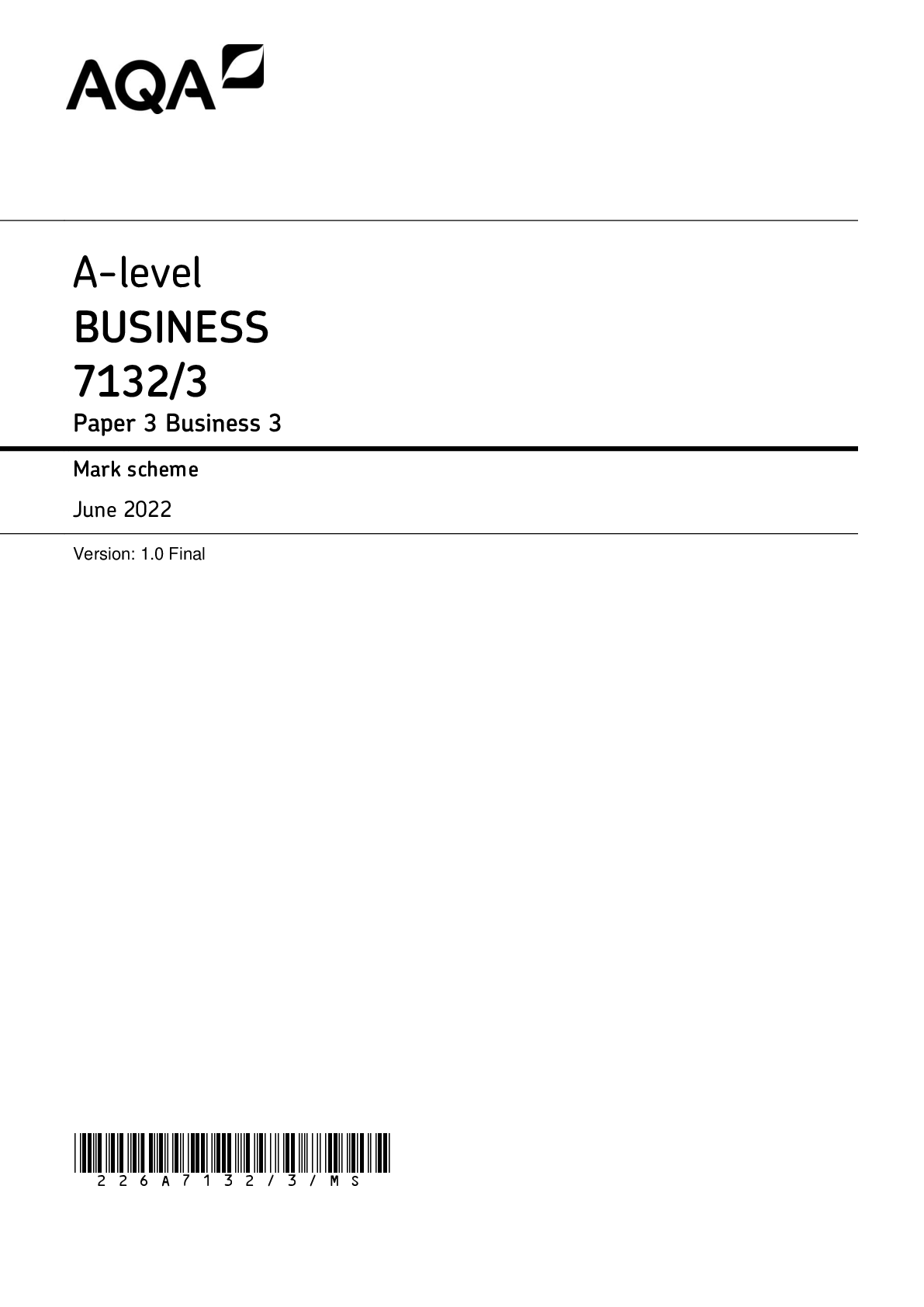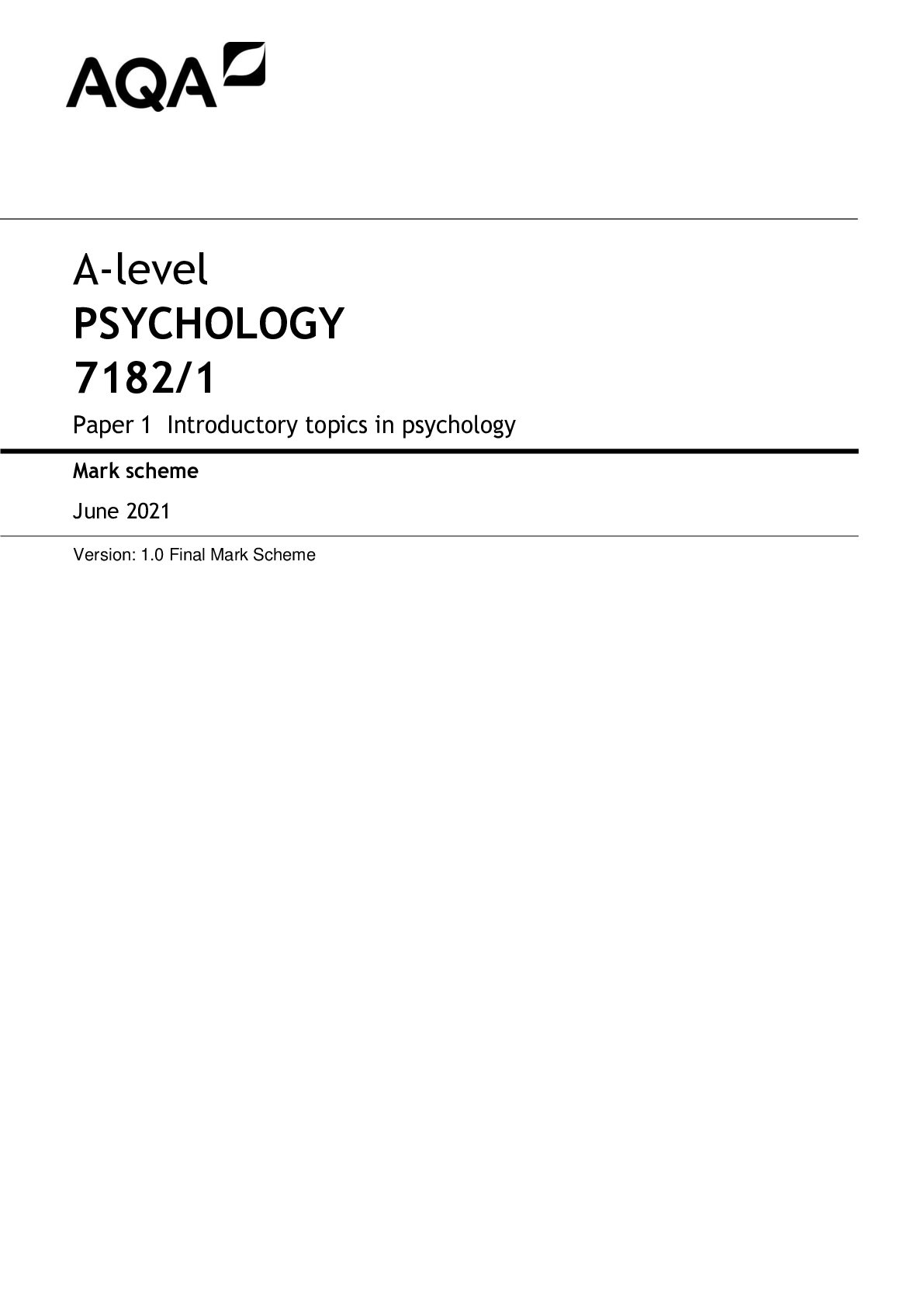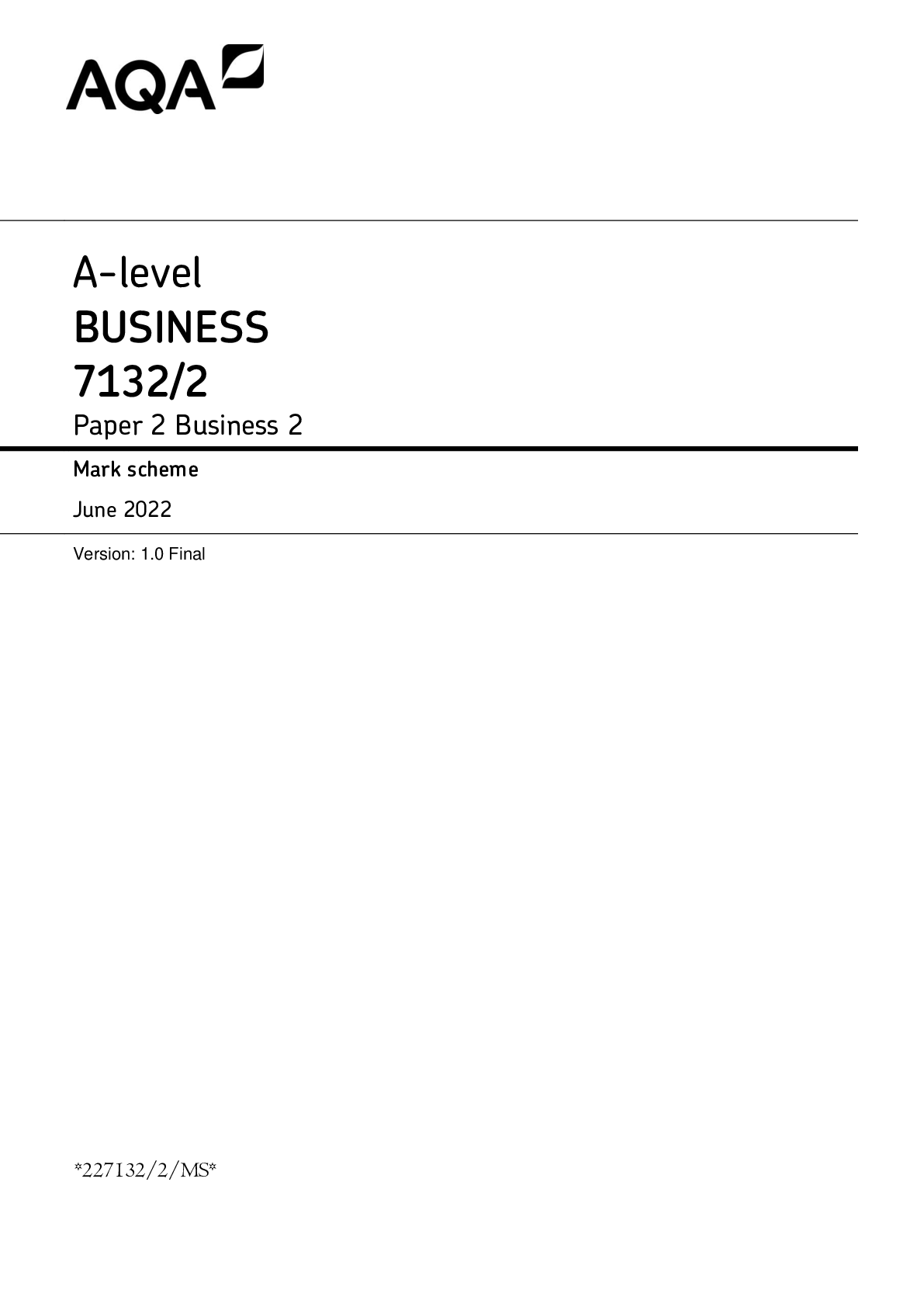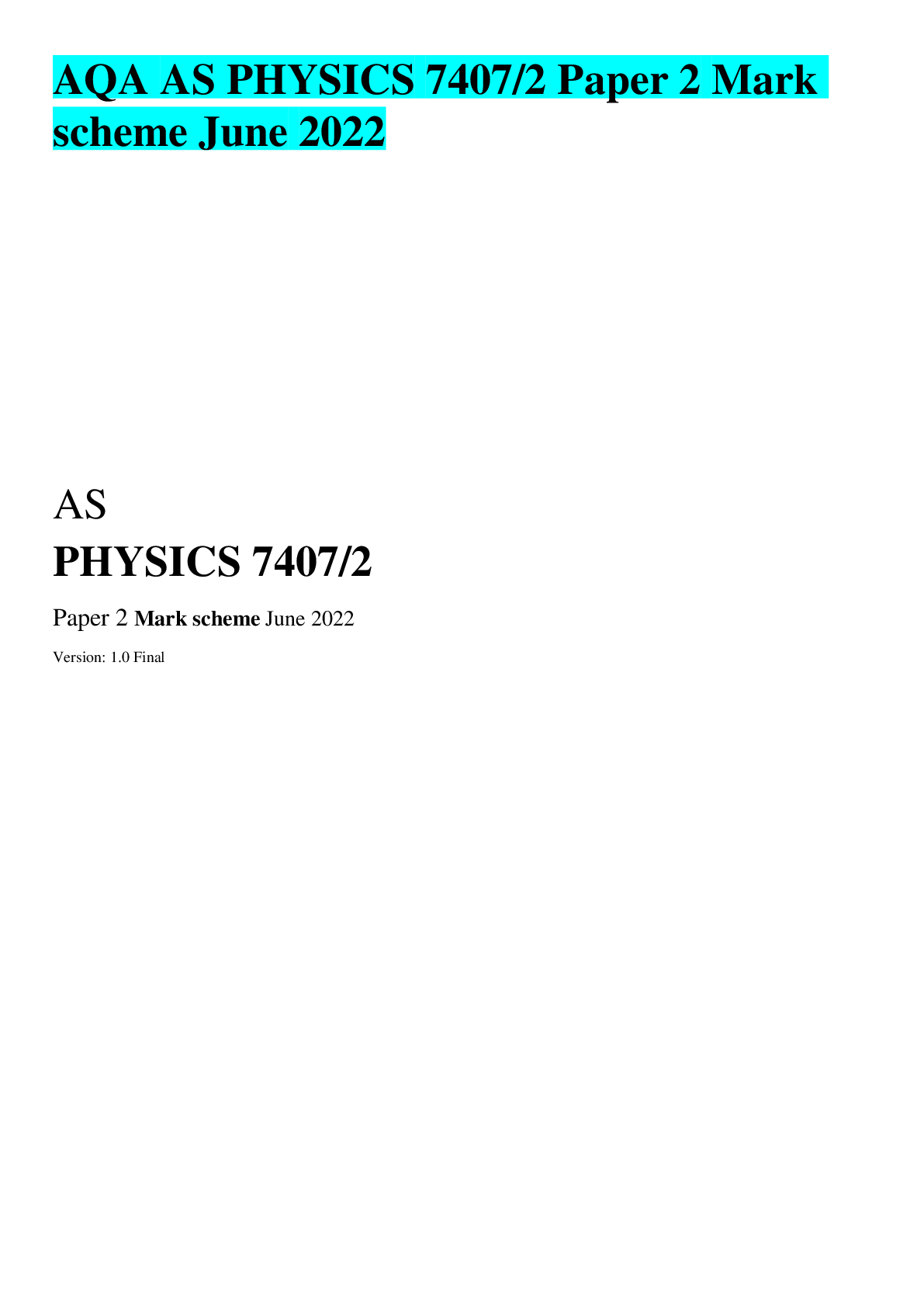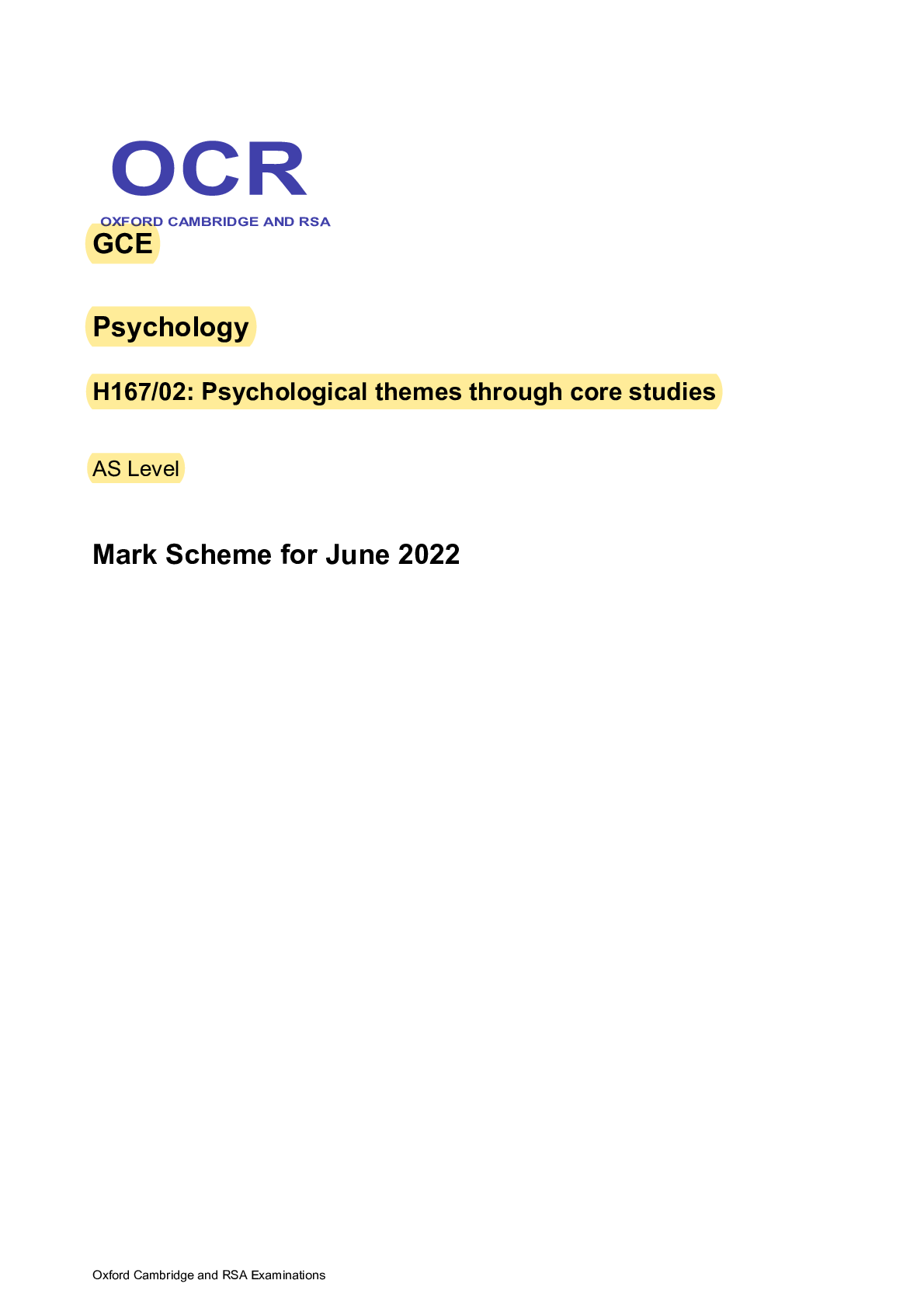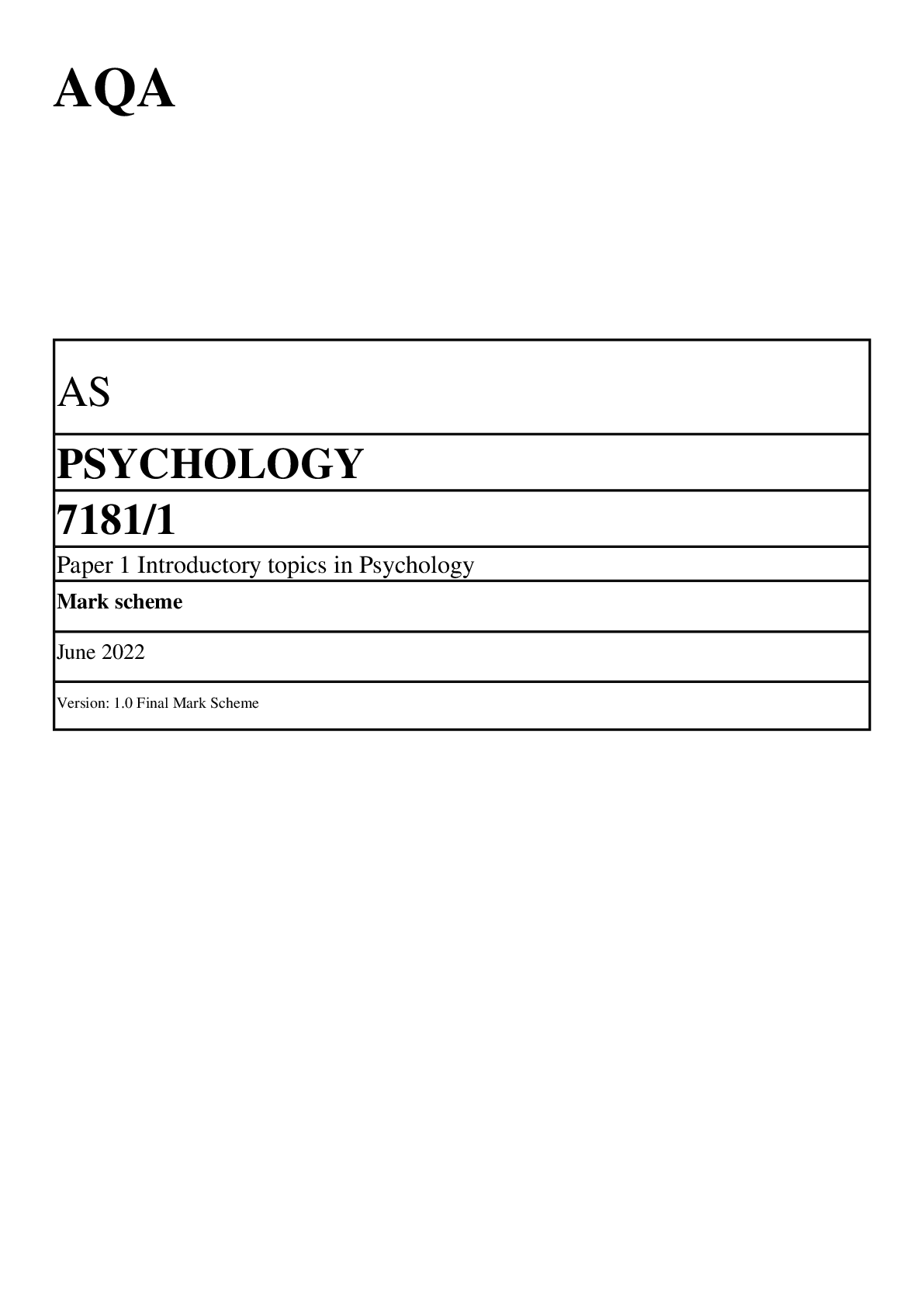Psychology > AS Level Mark Scheme > AS PSYCHOLOGY 7181/1 Paper 1 Introductory topics in Psychology Mark scheme June 2022 Version: 1.0 Fi (All)
AS PSYCHOLOGY 7181/1 Paper 1 Introductory topics in Psychology Mark scheme June 2022 Version: 1.0 Final Mark Scheme *226A7181/1/MS* MARK SCHEME – AS PSYCHOLOGY – 7181/1 – JUNE 2022 2
Document Content and Description Below
AS PSYCHOLOGY 7181/1 Paper 1 Introductory topics in Psychology Mark scheme June 2022 Version: 1.0 Final Mark Scheme *226A7181/1/MS* MARK SCHEME – AS PSYCHOLOGY – 7181/1 – JUNE 2022 2 ... Mark schemes are prepared by the Lead Assessment Writer and considered, together with the relevant questions, by a panel of subject teachers. This mark scheme includes any amendments made at the standardisation events which all associates participate in and is the scheme which was used by them in this examination. The standardisation process ensures that the mark scheme covers the students’ responses to questions and that every associate understands and applies it in the same correct way. As preparation for standardisation each associate analyses a number of students’ scripts. Alternative answers not already covered by the mark scheme are discussed and legislated for. If, after the standardisation process, associates encounter unusual answers which have not been raised they are required to refer these to the Lead Examiner. It must be stressed that a mark scheme is a working document, in many cases further developed and expanded on the basis of students’ reactions to a particular paper. Assumptions about future mark schemes on the basis of one year’s document should be avoided; whilst the guiding principles of assessment remain constant, details will change, depending on the content of a particular examination paper. Further copies of this mark scheme are available from aqa.org.uk Copyright information AQA retains the copyright on all its publications. However, registered schools/colleges for AQA are permitted to copy material from this booklet for their own internal use, with the following important exception: AQA cannot give permission to schools/colleges to photocopy any material that is acknowledged to a third party even for internal use within the centre. Copyright © 2022 AQA and its licensors. All rights reserved. MARK SCHEME – AS PSYCHOLOGY – 7181/1 – JUNE 2022 3 Level of response marking instructions Level of response mark schemes are broken down into levels, each of which has a descriptor. The descriptor for the level shows the average performance for the level. There are marks in each level. Before you apply the mark scheme to a student’s answer read through the answer and annotate it (as instructed) to show the qualities that are being looked for. You can then apply the mark scheme. Step 1 Determine a level Start at the lowest level of the mark scheme and use it as a ladder to see whether the answer meets the descriptor for that level. The descriptor for the level indicates the different qualities that might be seen in the student’s answer for that level. If it meets the lowest level then go to the next one and decide if it meets this level, and so on, until you have a match between the level descriptor and the answer. With practice and familiarity you will find that for better answers you will be able to quickly skip through the lower levels of the mark scheme. When assigning a level you should look at the overall quality of the answer and not look to pick holes in small and specific parts of the answer where the student has not performed quite as well as the rest. If the answer covers different aspects of different levels of the mark scheme you should use a best fit approach for defining the level and then use the variability of the response to help decide the mark within the level, ie if the response is predominantly level 3 with a small amount of level 4 material it would be placed in level 3 but be awarded a mark near the top of the level because of the level 4 content. Step 2 Determine a mark Once you have assigned a level you need to decide on the mark. The descriptors on how to allocate marks can help with this. The exemplar materials used during standardisation will help. There will be an answer in the standardising materials which will correspond with each level of the mark scheme. This answer will have been awarded a mark by the Lead Examiner. You can compare the student’s answer with the standardised examples to determine if it is the same standard, better or worse than the example. You can then use this to allocate a mark for the answer based on the Lead Examiner’s mark on the example. You may well need to read back through the answer as you apply the mark scheme to clarify points and assure yourself that the level and the mark are appropriate. Indicative content in the mark scheme is provided as a guide for examiners. It is not intended to be exhaustive and you must credit other valid points. Students do not have to cover all of the points mentioned in the Indicative content to reach the highest level of the mark scheme. An answer which contains nothing of relevance to the question must be awarded no marks. MARK SCHEME – AS PSYCHOLOGY – 7181/1 – JUNE 2022 4 Section A Social Influence 0 1 In Milgram’s experiment on obedience to authority, 65% of participants gave the maximum shock when the experimenter was in the same room as the participant. For variations of Milgram’s experiment, which of the following statements is true? [1 mark] Marks for this question: AO1 = 1 D – When the experimenter was in a different room to the participant, obedience levels decreased. 0 2 Explain what is meant by social change. [2 marks] Marks for this question: AO1 = 2 2 marks for a clear and coherent explanation of what is meant by social change. 1 mark for a muddled/limited explanation. Possible content: • whole societies, (not just individuals) change – essential for full marks • adopt new attitudes, beliefs or behaviours • through minority influence processes e.g snowball effect • examples of change: accepting the earth is round not flat; women’s suffragette movement; gay rights; environmental issues such as increased recycling, reduced smoking in public places. Credit other relevant content. MARK SCHEME – AS PSYCHOLOGY – 7181/1 – JUNE 2022 5 0 3 Steph’s psychology teacher is leaving at the end of term. Steph would like to organise a surprise fancy dress party for her, but the rest of the class are not convinced that it is a good idea. Use your knowledge of two or more factors affecting minority influence to explain how Steph can persuade the rest of her class to accept her idea. [6 marks] Marks for this question: AO2 = 6 Level Mark Description 3 5–6 Knowledge of two or more factors affecting minority influence is clear and generally well detailed. Application to Steph’s idea is mostly clear and effective. The answer is generally coherent with appropriate use of terminology. 2 3–4 Knowledge of two or more factors affecting minority influence is evident. There is some effective application to Steph’s idea. The answer lacks clarity in places. Terminology is used appropriately on occasions. OR one factor applied at level 3: max 3 marks. 1 1–2 Knowledge of two or more factors affecting minority influence is limited. Application to Steph’s idea is either absent or inappropriate. The answer as a whole lacks clarity and has inaccuracies. Terminology is either absent or inappropriately used. OR one factor applied at level 2. 0 No relevant content. Possible content: • Steph should demonstrate consistency by not deviating from her view that the party is a good idea despite social pressure – she could point out that this is an idea she has had for some time/since she knew the teacher was leaving • Steph should demonstrate commitment by placing herself at some risk/inconvenience – she may volunteer to pay for the refreshments/present for the teacher etc. This will draw more attention to her ‘cause’ (augmentation principle) • Steph should demonstrate flexibility by adapting her view/accepting other valid counterarguments, perhaps agreeing to change the party for her teacher, eg not fancy dress/not a surprise party • over time, the rest of the class may become ‘converted’ (snowball effect) – for example, if Steph’s friends start to change their mind, then others follow • other valid points, eg persistence, confidence, social cryptoamnesia. Description of procedures of studies of minority influence is not creditworthy. Description of findings/conclusions may be creditworthy but only if used to explain how Steph can persuade her classmates. MARK SCHEME – AS PSYCHOLOGY – 7181/1 – JUNE 2022 6 0 4 Describe the procedure of Zimbardo’s research into social roles. [6 marks] Marks for this question: AO1 = 6 Level Marks Description 3 5–6 Knowledge of the procedure of Zimbardo’s research into social roles is clear, detailed and generally accurate. The answer is generally coherent and specialist terminology is used appropriately. 2 3–4 Some knowledge of the procedure of Zimbardo’s research into social roles is evident but the answer lacks clarity. There is some appropriate use of specialist terminology. 1 1–2 Limited knowledge of the procedure of Zimbardo’s research into social roles is present. There may be inaccuracies, specialist terminology is either missing or inappropriately used. 0 No relevant content. Possible content: • observational study in basement at Stanford university • 24 US male student volunteers • psychological assessment: participants chosen psychologically stable and healthy • agreed to participate in a 7 to 14-day study • paid $15 a day • randomly assigned role of prisoner or guard • prisoners unexpectedly arrested at home • deloused, given prison uniform and ID number • small mock prison cells housed 3 prisoners each • given some rights, eg 3 meals, 3 supervised toilet trips a day and 2 visits per week • guards were given uniforms, clubs, whistles and wore reflective sunglasses • guards were told to run the prison but not harm the prisoners • guards worked in teams of 3 for 8-hour shifts and allowed off site after shift • Zimbardo took role of prison superintendent • planned duration was 2 weeks but stopped after 6 days. Credit other relevant content. MARK SCHEME – AS PSYCHOLOGY – 7181/1 – JUNE 2022 7 0 5 Explain one limitation of Zimbardo’s research into social roles. [3 marks] Marks for this question: AO3 = 3 3 marks for a clear and coherent explanation of a limitation of Zimbardo’s research into social roles. 2 marks for a less detailed explanation of a limitation which lacks some clarity and/or coherence. 1 mark for a muddled or limited explanation. Possible limitations: • ethical issues: lack of informed consent, whether or not the consent gained was sufficiently informed; deception; lack of protection from psychological harm – participants soon became distressed; whether or not the distress should have been anticipated; right to withdraw was initially declined • Zimbardo playing a ‘dual-role’/participant observer. Zimbardo’s own behaviour affected the way in which events unfolded, thus the validity of the findings could be questioned • methodological issues: sample bias; demand characteristics/lack of internal validity; lack of ecological validity/mundane realism and their implications for the findings • lack of supporting evidence/exact replication • over exaggeration of findings: only a third of participants conformed to roles Credit use of examples from the study to support argument and elaborate on the limitation given. Just naming a limitation is not creditworthy. If more than one limitation is identified credit the best one. Credit other valid limitations. MARK SCHEME – AS PSYCHOLOGY – 7181/1 – JUNE 2022 8 0 6 . 1 Identify the type of distribution that the data suggest for each of Groups A and B. In each case justify your answer. [4 marks] Marks for this question: AO2 = 4 1 mark for: • group A scores indicate a negatively skewed distribution Plus 1 mark for: • because the mean is lower than the median/mode or to the left-hand side of the distribution (accept alternative wording) and 1 mark for: • group B scores indicate a positively skewed distribution Plus 1 mark for: • because the mean is higher than the median/mode or to the right-hand side of the distribution (accept alternative wording) Do not credit explanation without correct identification. MARK SCHEME – AS PSYCHOLOGY – 7181/1 – JUNE 2022 9 0 6 . 2 Explain what the difference in mode values of the two age groups shows. [2 marks] Marks for this question: AO2 = 2 2 marks for a clear explanation of what the difference in mode values of the two age groups shows. 1 mark for a muddled or limited explanation. Possible content: • the most frequent conformity score in the younger age group was (a lot) higher than the most frequent conformity score in the older age group OR • the most frequent conformity score in the older age group was (a lot) lower than the most frequent conformity score in the younger age group. Accept other relevant content [Show More]
Last updated: 1 year ago
Preview 1 out of 18 pages
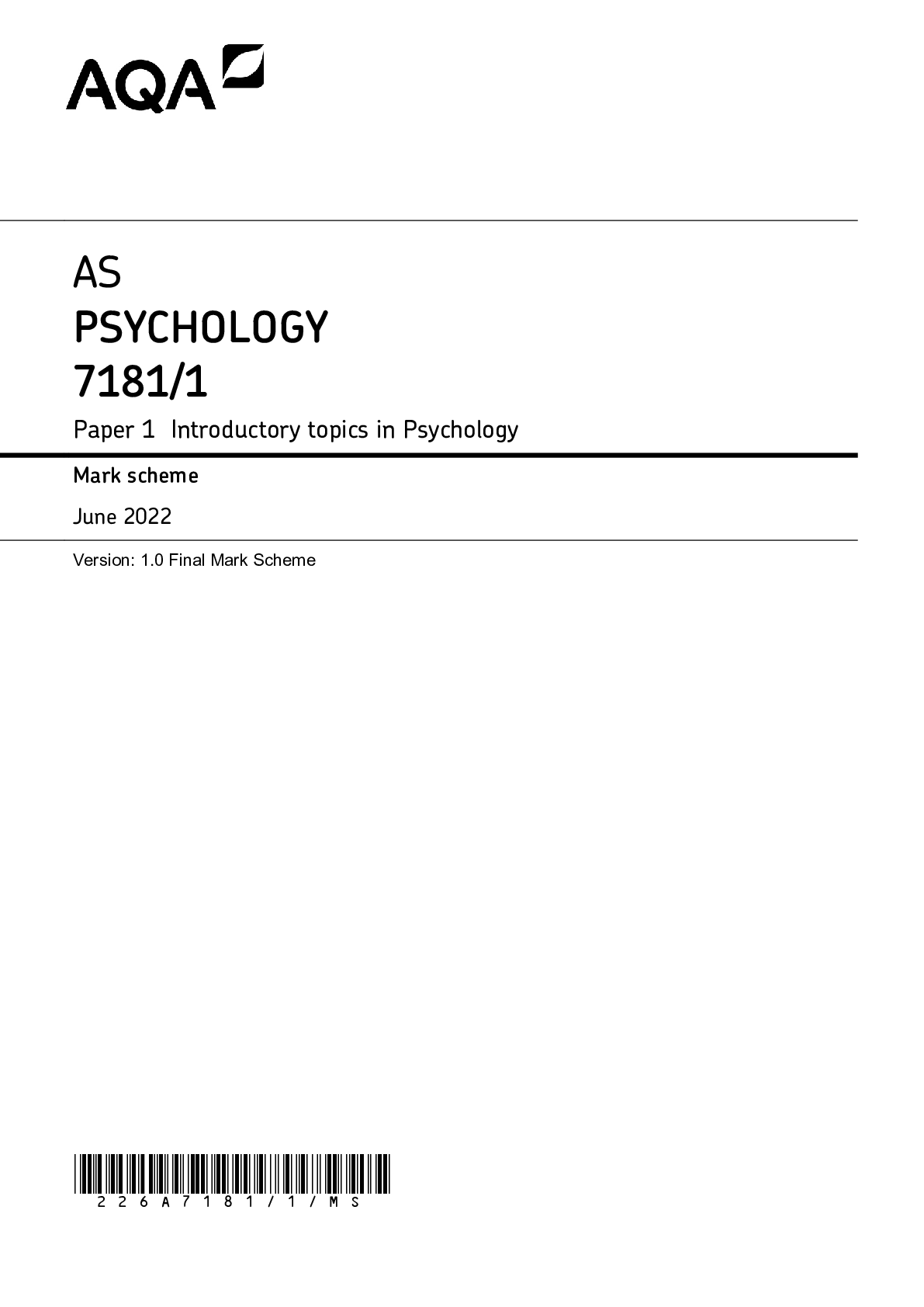
Reviews( 0 )
Document information
Connected school, study & course
About the document
Uploaded On
Apr 02, 2023
Number of pages
18
Written in
Additional information
This document has been written for:
Uploaded
Apr 02, 2023
Downloads
0
Views
80


